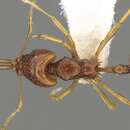pt-BR
nomes no trilho de navegação


There are seven extant species and one extinct species (Acanthognathus poinari) in this genus.
Ants of the genus Acanthognathus stalk small insects and catch their prey by a strike with their long, thin mandibles. The mandibles close in less than 2.5 ms and this movement is controlled by a specialized closer muscle. In Acanthognathus, unlike other insects, the mandible closer muscle is subdivided into two distinct parts: as in a catapult, a large slow closer muscle contracts in advance and provides the power for the strike while the mandibles are locked open. When the prey touches specialized trigger hairs, a small fast closer muscle rapidly unlocks the mandibles and thus releases the strike. The fast movement is steadied by large specialized surfaces in the mandible joint and the sensory-motor reflex is controlled by neurones with particularly large, and thus fast-conducting, axons.
Species in this genus are found in rotten logs, hollow twigs and branches and sections of wood burried in leaf litter. The colony size is rather small, often less than 20 workers. Individual foragers can be seen hunting collembola prey with mandibles wide open on the surface of leaf litter.
Central and South America
Mandibles linear and elongate, their bases extremely closely approximated and with kinetic mode of action, each with an apical fork of 3 spiniform teeth that interlock at full closure. Preapical dentition sometimes present but often absent. Mandibles at full gape open to 170 degrees or more. Basal process of mandible a long curved spur that is minutely bifurcated apically; when mandibles fully closed the basal processess cross over and are ventral to the labrum and at the apex of the labio-maxillary complex; when fully open the mandibles are braced in that position by opposition of the basal processes alone. Trigger hairs arise from the mandibles (one from each); trigger hairs lie flat against margin when mandible closed, becoming erect as mandibles open. Palp formula 0,1. Labrum extremely reduced to vestigal, represented by a narrow Y-shaped sclerite; labrum not taking part in mandibular locking mechanism. Buccal cavity narrow, parallel-sided anteriorly; labio-maxillary complex narrow.